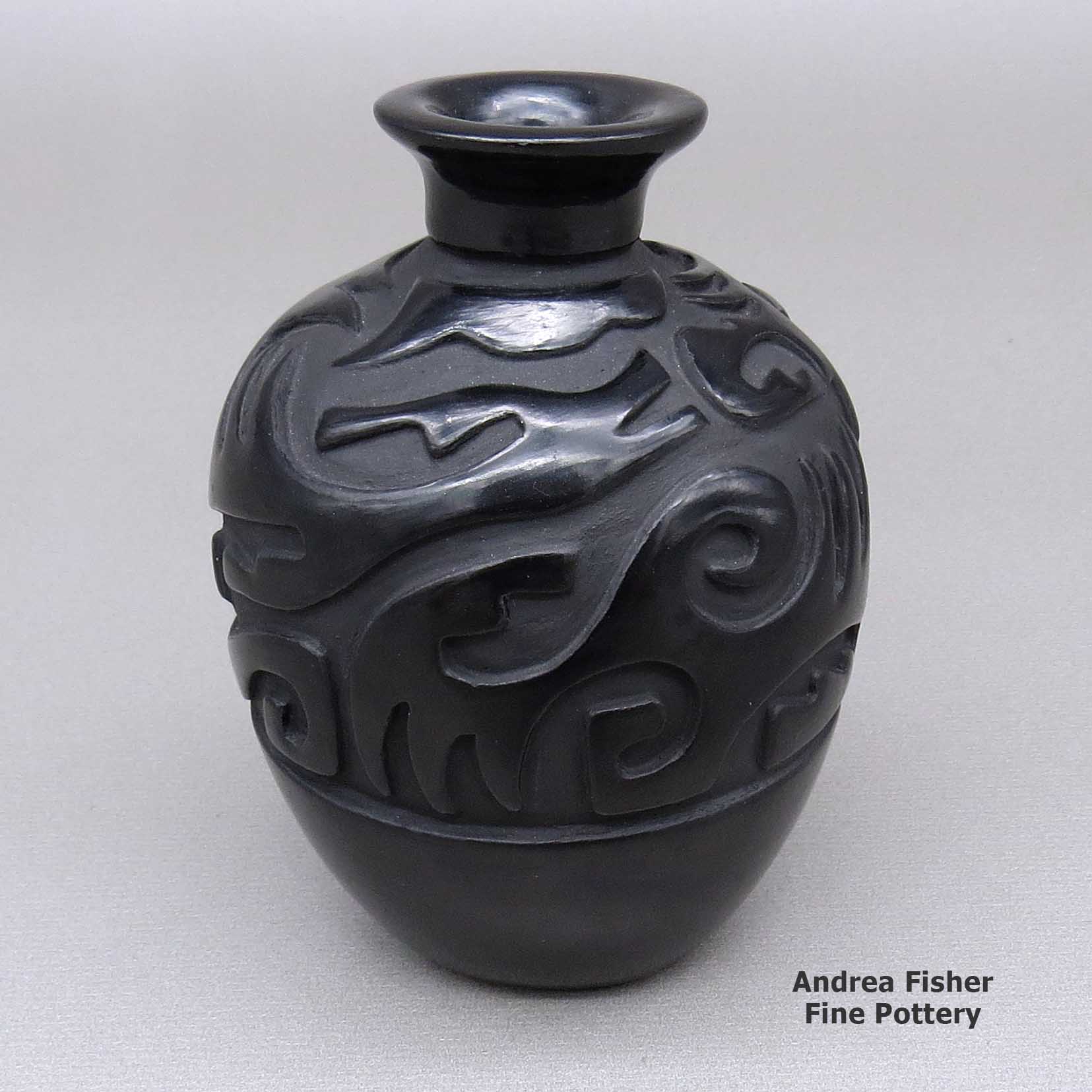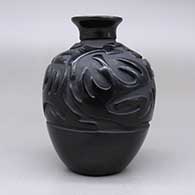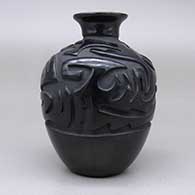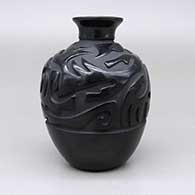
Tammy Garcia
Santa Clara
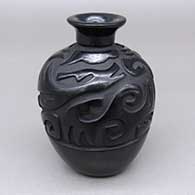
"Her work is sensual, her proportion is exquisite, the carving and design is superb. She's truly contemporary, but she's utilizing designs and motifs from centuries back. And if her work is anything less than superb, she won't sell it. It's that simple. Everything she does is blue ribbon." - Martha Albrecht, former President of the Wheelwright Museum, Santa Fe
Tammy Garcia was born into Santa Clara Pueblo in 1969. She is the daughter of Linda Cain, granddaughter of Mary and Willie Cain, great-granddaughter of Christina Naranjo. Autumn Borts-Medlock is her sister. Tammy learned to make pottery from her mother and was active in the marketplace as a teenager.
Working with clay, Tammy makes carved redware and blackware, seed pots, storage jars, jars and canteens. Her designs are inspired by ancient Anasazi and Mimbres designs, scenes and symbols from life in Santa Clara Pueblo, and scenes gathered from other Native American cultures.
The Museum of Indian Arts and Culture declared Tammy to be their 2013 Native Treasures Living Treasure.
Some Exhibits that Featured Tammy's Work
- Masters of the American West. Autry Museum of the American West. Los Angeles, California. February 27, 2021 - April 11, 2021. Note: virtual art show and sale.
- Layers: Life in Clay. King Galleries. Santa Fe, New Mexico. April 18, 2020 - May 2, 2020. Note: one-person show featuring new work by Tammy Garcia.
- Preston Singletary: Artist, Innovator, Collaborator. Blue Rain Gallery. Santa Fe, New Mexico. Opened August 6, 2019. Note: includes collaborative works by Preston Singletary with Harlan Reano, Jody Naranjo, and Tammy Garcia. Accompanied by an exhibition catalog.
- Masters of the American West. Autry Museum of the American West. Los Angeles, California. February 9, 2019 - March 24, 2019. Note: participating artists include Tony Abeyta, Tammy Garcia, Doug Hyde, Oreland C. Joe Sr., Kevin Red Star, Mateo Romero, and others.
- What's New in New: Selections from the Carol Warren Collection. Lloyd Kiva New Gallery, Museum of Indian Arts and Culture. Santa Fe, New Mexico. June 3, 2018 - February 26, 2019. Note: exhibiting works include art by artists Tony Abeyta, Autumn Borts-Medlock, Preston Duwyenie, Tammy Garcia, Dan Namingha, Les Namingha, Jody Naranjo, Roxanne Swentzell, and Tito Naranjo
- Masters of the American West. Autry Museum of the American West. Los Angeles, California. February 10, 2018 - March 25, 2018. Note: exhibiting artists include Tony Abeyta, Tammy Garcia, Oreland C. Joe Sr., Kevin Red Star, Mateo Romero, among others. Beauty Speaks for Us. Heard Museum. Phoenix, Arizona. February 10, 2017 - March 31, 2017. Creative Casting: Bronzes from the Heard Collection. Heard Museum. Phoenix, Arizona. Opened February 9, 2017.
- From the Belly of Our Being: Art by and about Native Creation. Oklahoma State University Museum of Art. Stillwater, Oklahoma. September 27, 2016 - January 28, 2017. Group exhibition curated by Heather Ahtone and includes the following artists: Keri Ataumbi, Julie Buffalohead, Nanibah Chacon, Anita Fields, Tammy Garcia, Shan Goshorn, Teri Greeves, Linda Lomahaftewa, Cedar Marie, Meryl McMaster, America Meredith, Molly Murphy Adams, Luanne Redeye, Cara Romero, Erin Shaw, C. Maxx Stevens, Marie Watt, Dyani White Hawk, Melanie Yazzie, and Debra Yepa-Pappan
- Something Old, Something New, Nothing Borrowed: New Acquisitions from the Heard Museum Collection. Heard Museum. Phoenix, Arizona. April 2, 2011 - March 18, 2012.
- Tammy Garcia and Preston Singletary. SOFA (Sculpture Objects Functional Art+Design) Exhibition. Chicago, Illinois. November 5-8, 2009.
- Visions Beyond Clay: The Artwork of Tammy Garcia. Rockwell Museum of Western Art. Corning, N.Y. May 23, 2009 - September 13, 2009
- Beyond Tradition: The Pueblo Pottery of Tammy Garcia. National Museum of Women in the Arts. Washington, DC. August 22, 2008 - February 3, 2009
- Crafted to Perfection: The Nancy & Alan Cameros Collection of Southwestern Pottery. Rockwell Museum of Western Art. Corning, N.Y. November 22, 2007 - May 18, 2008
- Origins in Tradition: Sculpture by Tammy Garcia. Museum of Indian Arts & Culture. Santa Fe, NM. May 20, 2007 - April 28, 2008
- Tammy Garcia: Visions in Glass, A Collaboration with Preston Singletary. Blue Rain Gallery. Santa Fe, NM. April 1, 2005 - April 30, 2005
- Breaking the Surface: Carved Pottery Techniques and Designs. Heard Museum. Phoenix, Arizona. October 2, 2004 - October 3, 2005
- Changing Hands: Art Without Reservation: Contemporary Native American Art from the Southwest. 2002-2003 Traveling exhibition planned for the following venues: American Craft Museum, New York, NY, May 9, 2002-September 15, 2002; Museum of Texas Tech University, Lubbock, TX, October 13, 2002-January 5, 2003; Philbrook Museum of Art, Tulsa, OK, January 19, 2003-March 16, 2003.
- Indian Market: New Directions in Southwestern Native American Pottery. Peabody Essex Museum. Salem, MA. 2001 November 16, 2001 - March 17, 2002
- Hold Everything! Masterworks of Basketry and Pottery from the Heard Museum. Heard Museum. Phoenix, Arizona. November 1, 2001 - March 10, 2002
Some of the Other Awards Tammy has Won
- 2020 Heard Museum Guild Indian Fair & Market, Classification - Sculpture V, Division C - Other media (ceramic, glass, wood, woven fabric, and all other materials): Second Place. Awarded for artwork: "Sikyatki Birds"
- 2019 Heard Museum Guild Indian Fair & Market, Classification V - Sculpture, Division B - Bronze: Second Place. Awarded for artwork: "Fish and Game, Edition 35"
- 2018 Heard Museum Guild Indian Fair & Market, Classification V - Sculpture, Division B - Bronze: First Place. Awarded for artwork: "Bear Fetish"
- 2008 The New Mexico Governor's Award for Excellence in the Arts
- 1998 Santa Fe Indian Market, Classification II - Pottery, Division C - Traditional pottery, carved or incised in the style of San Juan, San Ildefonso, Santa Clara, other tribe styles, Category 1001 - Jars (up to 7" all), First Place
- 1998 Santa Fe Indian Market, Classification II - Pottery, Division C - Traditional pottery, carved or incised in the style of San Juan, San Ildefonso, Santa Clara, other tribe styles, Category 1002 - Jars (over 7" tall): Second Place
- 1998 Santa Fe Indian Market, Classification II - Pottery, Division G - Non-traditional pottery, new forms, using traditional materials & techniques, Category 1404 - Jars: First Place
- 1997 Santa Fe Indian Market, Classification II - Pottery, Division C - Traditional pottery, carved or incised in the style of San Juan, San Ildefonso, Santa Clara, other tribal styles: Best of Division
- 1997 Santa Fe Indian Market, Classification II - Pottery, Division C - Traditional pottery, carved or incised in the style of San Juan, San Ildefonso, Santa Clara, other tribal styles, Category 1002, Jars - (over 7" tall): First Place
- 1997 Santa Fe Indian Market, Classification II - Pottery, Division C - Traditional pottery, carved or incised in the style of San Juan, San Ildefonso, Santa Clara, other tribal styles, Category 1009 - Miscellaneous, including canteens: Second Place
- 1996 Santa Fe Indian Market, Classification II - Pottery, Division C - Traditional pottery, carved or incised in the style of San Juan, San Ildefonso, Santa Clara, other tribal styles: Best of Division
- 1996 Santa Fe Indian Market, Classification II - Pottery, Division C - Traditional pottery, carved or incised in the style of San Juan, San Ildefonso, Santa Clara, other tribal styles, Category 1001 - Jars (up to 7" tall): First Place
- 1996 Santa Fe Indian Market, Classification II - Pottery, Division C - Traditional pottery, carved or incised in the style of San Juan, San Ildefonso, Santa Clara, other tribal styles, Category 1002 - Jars (over 7" tall): First Place
- 1996 Santa Fe Indian Market, Classification II - Pottery, Division C - Traditional pottery, carved or incised in the style of San Juan, San Ildefonso, Santa Clara, other tribal styles, Category 1006 - Wedding vases: Second Place
- 1996 Santa Fe Indian Market, Classification II - Pottery, Division C - Traditional pottery, carved or incised in the style of San Juan, San Ildefonso, Santa Clara, other tribal styles, Category 1009 - Miscellaneous, including canteens: First Place
- 1996 Santa Fe Indian Market, Classification II - Pottery, Division G - Non-traditional pottery, new forms, using traditional materials & techniques, Category 1410 - Miscellaneous (over 6") only items with figures or designs in relief: First Place
- 1995 Santa Fe Indian Market, Classification II - Pottery, Best of Classification
- 1995 Santa Fe Indian Market, Classification II - Pottery, Division D - Traditional pottery, carved: Best of Division
- 1995 Santa Fe Indian Market, Classification II - Pottery, Division D - Traditional pottery, carved, Category 1101 - Jars (up to 7 inches tall): First Place
- 1995 Santa Fe Indian Market, Classification II - Pottery, Division D - Traditional pottery, carved, Category 1102 - Jars (over 7 inches tall): First Place
- 1995 Santa Fe Indian Market, Classification II - Pottery, Division D - Traditional pottery, carved, Category 1102 - Jars (over 7 inches tall): Second Place
- 1995 Santa Fe Indian Market, Classification II - Pottery, Division J - Non-traditional, any forms using non-traditional materials or techniques, Category 1602 - Jars & vases, painted (other than stoneware): First Place
- 1994 Santa Fe Indian Market: Large Pottery Award - Best Traditional Pottery jar or bowl, 15" or more in height or diameter
- 1994 Santa Fe Indian Market, Classification II - Pottery, Division D - Traditional pottery, carved, Category 1101 - Jars (up to 7 inches tall): Second Place
- 1994 Santa Fe Indian Market, Classification II - Pottery, Division D - Traditional pottery, carved, Category 1102 - Jars (over 7 inches tall): Second Place
- 1994 Santa Fe Indian Market, Classification II - Pottery, Division D - Traditional pottery, carved, Category 1104 - Bowls (over 7 inches in diameter): Second Place
- 1988 Gallup InterTribal Ceremonial, Classification - Pottery, 402 - Jar, seed jar, canteen: Third Place
- 1988 Gallup InterTribal Ceremonial, Classification - Pottery, 403 - Vase, wedding vase: First Place
100 West San Francisco Street, Santa Fe, New Mexico 87501
(505) 986-1234 - www.andreafisherpottery.com - All Rights Reserved

Santa Clara Pueblo

Ruins at Puye Cliffs, Santa Clara Pueblo
Santa Clara Pueblo straddles the Rio Grande about 25 miles north of Santa Fe. Of all the pueblos, Santa Clara has the largest number of potters.
The ancestral roots of the Santa Clara people have been traced to the pueblos in the Mesa Verde region in southwestern Colorado. When that area began to get dry between about 1100 and 1300, some of the people migrated to the Chama River Valley and constructed Poshuouinge (about 3 miles south of what is now Abiquiu on the edge of the mesa above the Chama River). Eventually reaching two and three stories high with up to 700 rooms on the ground floor, Poshuouinge was inhabited from about 1375 to about 1475. Drought then again forced the people to move, some of them going to the area of Puye (on the eastern slopes of the Pajarito Plateau of the Jemez Mountains) and others to Ohkay Owingeh (San Juan Pueblo, along the Rio Grande). Beginning around 1580, drought forced the residents of the Puye area to relocate closer to the Rio Grande and they founded what we now know as Santa Clara Pueblo on the west bank of the river, between San Juan and San Ildefonso Pueblos.
In 1598 Spanish colonists from nearby Yunque (the seat of Spanish government near San Juan Pueblo) brought the first missionaries to Santa Clara. That led to the first mission church being built around 1622. However, the Santa Clarans chafed under the weight of Spanish rule like the other pueblos did and were in the forefront of the Pueblo Revolt of 1680. One pueblo resident, a mixed black and Tewa man named Domingo Naranjo, was one of the rebellion's ringleaders. When Don Diego de Vargas came back to the area in 1694, he found most of the Santa Clarans on top of nearby Black Mesa (with the people of San Ildefonso). An extended siege didn't subdue them so eventually, the two sides negotiated a treaty and the people returned to their pueblo. However, successive invasions and occupations by northern Europeans took their toll on the tribe over the next 250 years. The Spanish flu pandemic in 1918 almost wiped them out.
Today, Santa Clara Pueblo is home to as many as 2,600 people and they comprise probably the largest per capita number of artists of any North American tribe (estimates of the number of potters run as high as 1-in-4 residents).
Today's pottery from Santa Clara is typically either black or red. It is usually highly polished and designs might be deeply carved or etched ("sgraffito") into the pot's surface. The water serpent, ("avanyu"), is a traditional design motif of Santa Clara pottery. Another motif comes from the legend that a bear helped the people find water during a drought. The bear paw has appeared on their pottery ever since.
One of the reasons for the distinction this pueblo has received is because of the evolving artistry the potters have brought to the craft. Not only did this pueblo produce excellent black and redware, several notable innovations helped move pottery from the realm of utilitarian vessels into the domain of art. Different styles of polychrome redware emerged in the 1920's-1930's. In the early 1960's experiments with stone inlay, incising and double firing began. Modern potters have also extended the tradition with unusual shapes, slips and designs, illustrating what one Santa Clara potter said: "At Santa Clara, being non-traditional is the tradition." (This refers strictly to artistic expression; the method of creating pottery remains traditional).
Santa Clara Pueblo is home to a number of famous pottery families: Tafoya, Baca, Gutierrez, Naranjo, Suazo, Chavarria, Garcia, Vigil, Tapia - to name a few.
100 West San Francisco Street, Santa Fe, New Mexico 87501
(505) 986-1234 - www.andreafisherpottery.com - All Rights Reserved

Santa Clara
$ 1900
zzsc3h417
Small black jar with a carved stylized avanyu and geometric design
3 in L by 3 in W by 4.25 in H
Condition: Very good, normal wear
Signature: Tammy Borts Santa Clara Pueblo
Date Created: 1990
100 West San Francisco Street, Santa Fe, New Mexico 87501
(505) 986-1234 - www.andreafisherpottery.com - All Rights Reserved

Christina Naranjo Family Tree
Disclaimer: This "family tree" is a best effort on our part to determine who the potters are in this family and arrange them in a generational order. The general information available is questionable so we have tried to show each of these diagrams to living members of each family to get their input and approval, too. This diagram is subject to change should we get better info.
- Christina Naranjo (1891-1980) & Jose Victor Naranjo (1895-1942)
- Mary Cain (1916-2010) & Willie Cain
- Billy Cain (1950-2005)
- Joy Cain (1947-)
- Linda Cain (1949-)
- Autumn Borts (1967-)
- Tammy Garcia (1969-)
- Tina Diaz (1946-)
- Warren Cain (1951-)
- Douglas Tafoya
- Marjorie Tafoya Tanin
- Mary Louise Eckleberry (1921-2003)
- Darlene Eckleberry
- Victor (1958-) & Naomi Eckleberry
- Teresita Naranjo (1919-1999)
- Mildred Moore (Naranjo, 1941-) & Victor Naranjo
- Eldon Moore
- Ernie Moore
- Kelli Moore
- Rick Moore
- Stella Chavarria (1939-)
- Denise Chavarria (1959-)
- Joey Chavarria (1964-1987)
- Sunday Chavarria (1963-)
- Mildred Moore (Naranjo, 1941-) & Victor Naranjo
- Cecilia Naranjo & James Lee McLean
- Sharon Naranjo Garcia (1951-) & Lawrence Atencio (San Juan)
- Ira Atencio (1975-)
- Lawrence Thunder Atencio
- Judy (1962-) & Lincoln Tafoya (1954-)
- Cecilia Fawn Tafoya (1986-)
- Chelsea Tafoya
- Eli Tafoya (1991-)
- Josetta Tafoya (1993-)
- Lincoln A. Tafoya (1989-)
- Linette Tafoya (1989-)
- Sarah Ayla Tafoya (1987-)
- Sharon Naranjo Garcia (1951-) & Lawrence Atencio (San Juan)
- Mida Tafoya (1931-)
- Ethel Vigil (1950-)
- Kimberly Garcia (1978-)
- Mike Tafoya (1956-)
- Phyllis Tafoya (1955-) & Matthew Tafoya
- Sherry Tafoya (1956-)
- Phyllis & Marlin Hemlock (Seneca)
- Lincoln Tafoya (1954-)
- Matthew Tafoya (1953-)
- Ethel Vigil (1950-)
- Edward Mickey Naranjo and Gracie Naranjo (Navajo)
- Edward Mickey Naranjo Jr.
- Teresa Naranjo
- Tracy Naranjo
Some of the above info is drawn from Pueblo Indian Pottery, 750 Artist Biographies, by Gregory Schaaf, © 2000, Center for Indigenous Arts & Studies. Other info is derived from personal contacts with family members and through interminable searches of the Internet.
(505) 986-1234 - www.andreafisherpottery.com - All Rights Reserved



